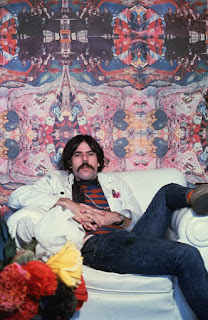What do you see in the images below?
What things repeat themselves?
Look for FIVE things you see more than once.....
1. Bright blends of colors,
2. Colors of objects are abstract and unnatural.
3. Radiating lines from center of an image.
4. Stars, circles or shapes floating around the image.
5. Faces in Profile in the sky or within objects.
6. Application is Solid/Printed/Graphic looking.
The man behind these designs is PETER MAX!
Have fun looking at more of these designs from the same artist...
One Groovy Dude
Peter Max (born Peter Max Finkelstein, October 19, 1937, is a German-American artist known for using abstract bright colors in his work. Works by Max are associated with the visual arts and culture of the 1960s, particularly dreamlike art and pop art.
Learn alot more about him here...
TEN THINGS YOU SHOULD KNOW ABOUT PETER MAX
Younger Peter
Your Assignment
You will choose an object of choice
(banana, dinosaur, trombone, mushroom, pencil, your own face... anything).
Draw this object as the largest thing on your paper.
Using the FIVE characteristics from Peter Max,
Create a dreamlike background behind your image.
------------------------------------------------------------------------------------------------
I did a small 3by5 sketch of my idea.
My object was a paint pallet with a profile view of my face behind it.
I used the cloud clusters, stars, planets, radiating lines to mimic his style as well.

I then used black permanent marker to outline the design.
Coloring was the challenge......
Most of the poster I am using markers, specifically BIC permanent marker collection.
This will give it the graphic/solid look that Peter Max has on his early designs.
Peter Max uses an ombre, color blending technique on his posters.
Getting that look is hard with markers.
You can use colored pencil or crayon to get the look.
Here's how....
Pick 2 colors that will blend well together with each-other.
One should be a darker.
Use the darker color first to create a smooth value scale.
Use the lighter color using hard pressure over the entire area left.
The 2 colors will blend if you did this correctly.
I will post finished picture at the top when completed...




































































